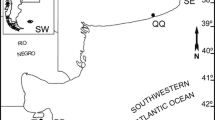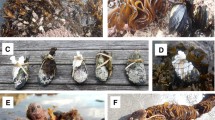Summary
Several aspects of disturbance by waves to intertidal boulders were monitored for one year high and low on the shore on two rock platforms on the east coast of Australia. These boulders were also subjected to burial by sand, and this disturbance was monitored in the same places for two years. The mobile and sessile organisms on the tops and bottoms of the rocks were sampled six times during the same period in order to determine patterns in community structure and assess the role of disturbance. Small rocks were overturned more often and buried to a greater extent than large rocks, but rocks of all sizes were moved similar distances with similar frequency. These contrasting results were probably caused by the fact that small rocks were rounder than large rocks. Rocks were buried in sand much more at Long Reef than at Cape Banks, but differences among places in disturbance by waves were not great.
Patterns in community structure were complex but suggested that disturbance was only important for sessile organisms on the undersides of boulders. The number of sessile species present was always related to the size of the rock but the total cover of algae on the tops of rocks never was. Some particular species were most abundant on large rocks but others showed the reverse pattern, covering more space on the smaller boulders. This latter pattern may have been due to the shorter period of exposure during low tide in this situation, though grazers were also abundant on these rocks in some places. In contrast, nearly all species on the undersides of rocks reached greatest abundance on the medium to large rocks, consistent with effects of disturbance. Space was in short supply low on the shore and overgrowth apparently reduced diversity but this was not the case elsewhere. Overall, the results indicate that disturbance was frequent and important, but not for all species nor in all places.
Similar content being viewed by others
References
Canny MJ (1981) A universe comes into being when a space is severed: some properties of boundaries in open systems. Proc Ecol Soc Aust 11:1–11
Connell JH (1978) Diversity in tropical rain-forests and coral reefs. Science 199:1302–1310
Connell JH, Keough MJ (1983) Disturbance and patch dynamics of subtidal marine animals on hard substrata. In: Pickett STA, White PS (eds) The ecology of natural disturbance and patch dynamics. Academic Press, New York, pp 125–147
Connell JH, Sousa WP (1983) On the evidence needed to judge ecological stability or persistence. Am Nat 121:789–824
Connor EF, McCoy ED (1979) The statistics and biology of the species-area relationship. Am Nat 113:791–833
Dayton PK (1971) Competition, disturbance and community organization: the provision and subsequent utilization of space in a rocky intertidal community. Ecol Monogr 41:351–389
Dethier MN (1984) Disturbance and recovery in intertidal pools: maintenance of mosaic patterns. Ecol Monogr 54:99–118
Ebling AW, Laur DR, Rowley RJ (1985) Severe storm disturbances and reversal of community structure in a Southern California kelp forest. Mar Biol 84:287–294
Fairweather PG (1985) Differential predation on alternative prey, and the survival of rocky intertidal organisms in New South Wales. J Exp Mar Biol Ecol 89:135–156
Fletcher WJ, Day RW (1983) The distribution of epifauna on Ecklonia radiata (Agardh) and the effect of disturbance. J Exp Mar Biol Ecol 71:205–220
Garwood NC, Janos DP, Brokaw NVL (1979) Earthquake-caused landslides; a major disturbance to tropical forests. Science 205:997–999
Grime JP (1973) Competitive exclusion in herbaceous vegetation. Nature 242:344–347
Grime JP (1979) Competition and the struggle for existence. In: Anderson RM, Turner BD, Taylor LR (eds) Population Dynamics. Blackwell Scientific Publications, Oxford, pp 123–140
Huitema BE (1980) Analysis of Covariance and Alternatives. John Wiley & Sons, Interscience, New York, London
Jernakoff P (1983) Factors affecting the recruitment of algae in a midshore region dominated by barnacles. J Exp Mar Biol Ecol 67:17–31
Jernakoff P (1985a) An experimental evaluation of the influence of barnacles, crevices and seasonal patterns of grazing on algal diversity and cover in an intertidal barnacle zone. J Exp Mar Biol Ecol 88:287–302
Jernakoff P (1985b) Temporal and small-scale spatial variability of algal abundance on an intertidal rocky shore. Bot Mar 28:145–154
Littler MM, Littler DS (1981) Intertidal macrophyte communities from Pacific Baja California and the upper Gulf of California: relatively constant vs. environmentally fluctuating systems. Mar Ecol Prog Ser 4:145–158
McGuinness KA (1984a) Equations and explanations in the study of species-area curves. Biol Rev 59:423–440
McGuinness KA (1984b) The species-area relations of the communities on intertidal boulders: testing the null hypothesis. J Biogeogr 11:439–456
McGuinness KA (1984c) Communities of organisms on intertidal boulders: the effects of disturbance and other factors. Unpublished PhD thesis, University of Sydney, Australia
McGuinness KA (1987) Disturbance and organisms on boulders. II. Causes of patterns in diversity and abundance. Oecologia (Berlin) 71:420–430
McGuinness KA, Underwood AJ (1986) Habitat structure and the nature of communities on intertidal boulders. J Exp Mar Biol Ecol (in press)
Osman RW (1977) The establishment and development of a marine epifaunal community. Ecol Monogr 47:37–63
Paine RT, Levin SA (1981) Intertidal landscapes: disturbance and the dynamics of patterns. Ecol Monogr 51:145–178
Pope EC (1937) Animal and plant communities of the coastal rock-platform at Long Reef, New South Wales. J Linn Soc NSW 68:221–254
Rykiel EJ (1985) Towards a definition of ecological disturbance. Aust J Ecol 10:361–366
Sousa WP (1979a) Experimental investigations of disturbance and ecological succession in a rocky intertidal algal community. Ecol Monogr 49:227–254
Sousa WP (1979b) Disturbance in marine intertidal boulder fields: the nonequilibrium maintenance of species diversity. Ecology 60:1225–1239
Sousa WP (1980) The responses of a community to disturbance: the importance of successional age and species life histories. Oecologia (Berlin) 45:72–81
Sousa WP (1980) The role of disturbance in natural communities. Ann Rev Ecol Syst 15:353–392
Taylor PR, Littler MM (1982) The roles of compensatory mortality, physical disturbance, and substrate retention in the development and organization of a sand-influenced, rocky intertidal community. Ecology 63:135–146
Thistle D (1981) Natural physical disturbances and communities of marine soft bottoms. Mar Ecol Prog Ser 6:223–228
Turner T (1983) Complexity of early and middle successional stages in a rocky intertidal surfgrass community. Oecologia (Berlin) 60:56–65
Underwood AJ (1977) Movements of intertidal gastropods. J Exp Mar Biol Ecol 26:191–201
Underwood AJ (1980) The effects of grazing by gastropods and physical factors on the upper limits of distribution of intertidal macroalgae. Oecologia (Berlin) 46:201–213
Underwood AJ (1981) Structure of a rocky intertidal community in New South Wales: patterns of vertical distribution and seasonal changes. J Exp Mar Biol Ecol 51:57–85
Underwood AJ (1985) Physical factors and biological interactions: the necessity and nature of ecological experiments. In: Moore PG, Seed R (eds) The ecology of rocky coasts. Hodder and Stoughton, London, pp 372–390
Underwood AJ, Jernakoff P (1981) Effects of interactions between algae and grazing gastropods on the structure of a low-shore intertidal algal community. Oecologia (Berlin) 48:221–233
Underwood AJ, Jernakoff P (1981) The effects of tidal height, wave-exposure and rock pools on grazing and the distribution of intertidal macro-algae. J Exp Mar Biol Ecol 75:71–96
Underwood AJ, Denley EJ, Moran MJ (1983) Experimental analyses of the structure and dynamics of mid-shore rocky intertidal communities in New South Wales. Oecologia (Berlin) 56:202–219
White PS, Pickett STA (1984) Natural disturbance and patch dynamics: an introduction. In: Pickett STA, White PS (eds) The ecology of natural disturbance and patch dynamics. Academic Press, New York, pp 3–13
Winer BJ (1971) Statistical Principles in Experimental Design (second edition). International Student Edition. McGraw-Hill Kogakusha Ltd, Tokyo
Wulff JL, Buss LW (1979) Do sponges help hold coral reefs together? Nature 281:474–475
Author information
Authors and Affiliations
Rights and permissions
About this article
Cite this article
McGuinness, K.A. Disturbance and organisms on boulders. Oecologia 71, 409–419 (1987). https://doi.org/10.1007/BF00378715
Received:
Issue Date:
DOI: https://doi.org/10.1007/BF00378715




